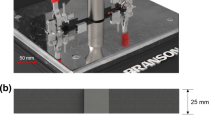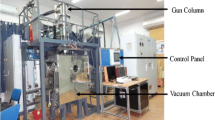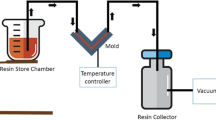Abstract
In this study, a new hybrid artificial intelligence approach is proposed to model the ultrasonic welding of a polymeric material blend. The proposed approach is composed of an ensemble random vector functional link model (ERVFL) integrated with a gradient-based optimizer (GBO). First, welding experiments were conducted on acrylonitrile butadiene styrene (ABS) and polycarbonate (PC) blends produced by the injection molding method. The experiments were designed according to the L27 orthogonal array considering three process factors (applied pressure, welding time, and vibration amplitude) and two responses (average temperature and joint strength). Then, the obtained experimental data were used to train the developed model. To verify the accuracy of the model, it was compared with standalone ERVFL in addition to two fine-tuned ERVFL models (ERVFL-SCA and ERVFL-MRFO) in which ERVFL is incorporated with sine cosine algorithm (SCA) or Manta ray foraging optimization (MRFO). The four models were evaluated using five statistical tools. ERVFL-GBO has the highest coefficient of determination and the lowest root mean square error, mean relative error mean absolute error, and coefficient of variance compared with other models which indicate its high accuracy over other tested models.















Similar content being viewed by others
References
Khoshaim AB, Elsheikh AH, Moustafa EB, Basha M, Showaib EA (2021) Experimental investigation on laser cutting of PMMA sheets: effects of process factors on kerf characteristics. J Mater Res Technol 11:235–246
Singh R, Kumar R, Feo L, Fraternali F (2016) Friction welding of dissimilar plastic/polymer materials with metal powder reinforcement for engineering applications. Composites Part B: Eng 101:77–86
Eslami S, de Figueiredo MAV, Tavares PJ, Moreira PMGP (2018) Parameter optimisation of friction stir welded dissimilar polymers joints. Int J Advanced Manufact Technol 94:1759–1770
Juhl TB, Bach D, Larson RG, Christiansen Jd, Jensen EA (2013) Predicting the laser weldability of dissimilar polymers. Polymer 54:3891–3897
AbuShanab WS, Abd Elaziz M, Ghandourah EI, Moustafa EB, Elsheikh AH (2021) A new fine-tuned random vector functional link model using Hunger games search optimizer for modeling friction stir welding process of polymeric materials. J Mater Res Technol 14:1482–1493
Juhl TB, Christiansen J d, Jensen EA (2013) Investigation on high strength laser welds of polypropylene and high-density polyethylene. J Appl Polymer Sci 129:2679–2685
Singh R, Kumar R, Ahuja IPS Friction welding for functional prototypes of PA6 and ABS with Al powder reinforcement, Proceedings of the National Academy of Sciences, India Section A: Physical Sciences
Rezaee Hajideh M, Shapurgan O, Molla Ramzani N, Hasan Nejad E (2017) Friction stir welding of dissimilar poly methyl methacrylate and polycarbonate sheets. J Modern Processes Manufact Prod 6:35–46
Akué Asséko AC, Cosson B, Lafranche É, Schmidt F, Le Maoult Y (2016) Effect of the developed temperature field on the molecular interdiffusion at the interface in infrared welding of polycarbonate composites. Composites Part B: Eng 97:53–61
Bindal T, Saxena RK, Pandey S (2021) Investigating friction spin welding of thermoplastics in shear joint configuration. SN Appl Sci 3:178
Stokes VK (2003) Experiments on the induction welding of thermoplastics. Polymer Eng Sci 43:1523–1541
Brassard D, Dubé M, Tavares JR (2019) Resistance welding of thermoplastic composites with a nanocomposite heating element. Composites Part B: Eng 165:779–784
Jongbloed B, Teuwen J, Benedictus R, Villegas IF (2020) On differences and similarities between static and continuous ultrasonic welding of thermoplastic composites. Composites Part B: Eng 203:108466
Zhang G-P, Li J-C, Liu Z-X, Wang P-C (2020) Application of ultrasonic welding to repair adhesively bonded short carbon fiber reinforced Nylon 6 composites. Int J Adhesion Adhesives 100:102603
Palardy G, Shi H, Levy A, Le Corre S, Fernandez Villegas I (2018) A study on amplitude transmission in ultrasonic welding of thermoplastic composites. Composites Part A: Appl Sci Manufact 113:339–349
Zongbo Z, **aodong W, Yi L, Zhenqiang Z, Liding W (2009) Study on heating process of ultrasonic welding for thermoplastics. J Thermoplastic Composite Mater 23:647–664
Villegas IF (2019) Ultrasonic welding of thermoplastic composites, Frontiers in Materials, 6
Balle F, Wagner G, Eifler D (2009) Ultrasonic metal welding of aluminium sheets to carbon fibre reinforced thermoplastic composites. Advanced Eng Mater 11:35–39
Kumar R, Singh R (2020) Application of nano porous materials for energy conservation and storage. In: Hashmi S, Choudhury IA (eds) Encyclopedia of Renewable and Sustainable Materials. Elsevier, Oxford, pp 42–50
Wu WI, Rezai P, Hsu HH, Selvaganapathy PR (2013) 1 - Materials and methods for the microfabrication of microfluidic biomedical devices, in: X. Li, Y. Zhou (Eds.) Microfluidic Devices for Biomedical Applications, Woodhead Publishing, pp. 3-62.
Aid S, Eddhahak A, Ortega Z, Froelich D, Tcharkhtchi A (2017) Experimental study of the miscibility of ABS/PC polymer blends and investigation of the processing effect. J Appl Polymer Sci 134
Bärwinkel S, Seidel A, Hobeika S, Hufen R, Mörl M, Altstädt V (2016) Morphology formation in PC/ABS blends during thermal processing and the effect of the viscosity ratio of blend partners. Materials 9:659
Zhao YQ, Liu QJ, Guo RB, Chen FQ, Qu JP, ** G (2014) Morphology, Mechanical and thermal properties of recycled PC/ABS blends processed via vane extruder. Int Polym Process 29:207–213
Shieu F-S, Wang B-H (1995) On the microstructure and tensile strength of PC/ABS polymer blend joints. J Polym Res 2:263–267
Stokes VK (2000) The vibration welding of polycarbonate/acrylonitrile-butadiene-styrene blends to themselves and to other resins and blends. Polym Eng Sci 40:2175–2181
Ülker A, Öztoprak N, Sayer S, Yeni C (2017) Optimization of welding parameters of hot plate welded PC/ABS blends by using the Taguchi experimental design method. J Elastomers Plastics 50:162–181
Stokes VK, Conway KR (2001) A phenomenological study of the hot-tool welding of thermoplastics. 4. Weld strength data for several blends. Polymer 42:7477–7493
Kumar S, Roy BS (2020) A comparative analysis between conventional tool and double-step shoulder tool for joining of acrylonitrile butadiene styrene and polycarbonate plate by using friction stir welding. Mater Today: Proc 26:2212–2215
Natesh M, Yun L, Arungalai Vendan S, Ramesh Kumar KA, Gao L, Niu X, Peng X, Garg A (2019) Experimental and numerical procedure for studying strength and heat generation responses of ultrasonic welding of polymer blends. Measurement 132:1–10
Chinnadurai T, Prabaharan N, Raj NM, Pandian MK (2018) Ultrasonically welded and non-welded polypropylene and PC-ABS blend thermal analysis. J Thermal Analysis Calorimetry 132:1813–1824
Chinnadurai T, Arungalai Vendan S (2017) Thermal and structural analysis of ultrasonic-welded PC/ABS blend for automobile applications. J Thermal Analysis Calorimetry 127:1995–2003
Qiu J, Zhang G, Sakai E, Liu W, Zang L (2020) Thermal welding by the third phase between polymers: a review for ultrasonic weld technology developments. Polymers 12:759
Showaib EA, Elsheikh AH (2020) Effect of surface preparation on the strength of vibration welded butt joint made from PBT composite. Polymer Testing 83:106319
Elsheikh AH, Deng W, Showaib EA (2020) Improving laser cutting quality of polymethylmethacrylate sheet: experimental investigation and optimization. J Mater Res Technol 9:1325–1339
Jedrasiak P, Shercliff HR (2018) Finite element analysis of heat generation in dissimilar alloy ultrasonic welding. Mater Design 158:184–197
Satpathy MP, Sahoo SK (2017) Experimental and numerical studies on ultrasonic welding of dissimilar metals. Int J Advanced Manufact Technol 93:2531–2545
Elsheikh AH, Guo J, Huang Y, Ji J, Lee K-M (2018) Temperature field sensing of a thin-wall component during machining: numerical and experimental investigations. Int J Heat Mass Transfer 126:935–945
Salman K h, Elsheikh AH, Ashham M, Ali MKA, Rashad M, Haiou Z (2019) Effect of cutting parameters on surface residual stresses in dry turning of AISI 1035 alloy. J Brazilian Soc Mech Sci Eng 41:349
Elsheikh AH, Shanmugan S, Muthuramalingam T, Thakur AK, Essa FA, Ibrahim AMM, Mosleh AO (2021) A comprehensive review on residual stresses in turning, Advances in Manufacturing
Javadi Y, Sadeghi S, Najafabadi MA (2014) Taguchi optimization and ultrasonic measurement of residual stresses in the friction stir welding. Mater Design 55:27–34
Siddani JK, Srinvas C, Madan N Mohan R, Srinvias Naik L (2020) Investigation of process parameters of ultrasonic welding of copper using Taguchi and grey relational analysis, Materials Today: Proceedings
Kalyan Kumar R, Omkumar M (2020) Ultrasonic welding of GF/PA6T composites: experimental investigation and process optimization, Materials Today: Proceedings
Elsheikh AH, Sharshir SW, Abd Elaziz M, Kabeel AE, Guilan W, Haiou Z (2019) Modeling of solar energy systems using artificial neural network: a comprehensive review. Solar Energy 180:622–639
Shehabeldeen TA, Elaziz MA, Elsheikh AH, Zhou J (2019) Modeling of friction stir welding process using adaptive neuro-fuzzy inference system integrated with harris hawks optimizer. J Mater Res Technol 8:5882–5892
Elsheikh, T.A. Shehabeldeen, J. Zhou, E. Showaib, MAE (2020) Prediction of laser cutting parameters for polymethylmethacrylate sheets using random vector functional link network integrated with equilibrium optimizer. J Intell Manufact
Khoshaim AB, Elsheikh AH, Moustafa EB, Basha M, Mosleh AO (2021) Prediction of residual stresses in turning of pure iron using artificial intelligence-based methods. J Mater Res Technol
Li Y, Lee TH, Wang C, Wang K, Tan C, Banu M, Hu SJ (2018) An artificial neural network model for predicting joint performance in ultrasonic welding of composites. Procedia CIRP 76:85–88
Li Y, Yu B, Wang B, Lee TH, Banu M (2020) Online quality inspection of ultrasonic composite welding by combining artificial intelligence technologies with welding process signatures. Mater Design 194:108912
Mongan PG, Hinchy EP, O’Dowd NP, McCarthy CT (2020) Optimisation of ultrasonically welded joints through machine learning. Procedia CIRP 93:527–531
Satpathy MP, Moharana BR, Dewangan S, Sahoo SK (2015) Modeling and optimization of ultrasonic metal welding on dissimilar sheets using fuzzy based genetic algorithm approach. Eng Sci Technol Int J 18:634–647
Oliva D, Elaziz MA, Elsheikh AH, Ewees AA (2019) A review on meta-heuristics methods for estimating parameters of solar cells. J Power Sources 435:126683
Elsheikh AH, Abd Elaziz M (2019) Review on applications of particle swarm optimization in solar energy systems. Int J Environ Sci Technol 16:1159–1170
Abd Elaziz M, Elsheikh AH, Oliva D, Abualigah L, Lu S, Ewees AA (2021) Advanced metaheuristic techniques for mechanical design problems: review, archives of computational methods in engineering
Elsheikh AH, Muthuramalingam T, Abd Elaziz M, Ibrahim AMM, Showaib EA (2021) Minimization of fume emissions in laser cutting of polyvinyl chloride sheets using genetic algorithm. Int J Environ Sci Technol
Shehabeldeen TA, Elaziz MA, Elsheikh AH, Hassan OF, Yin Y, Ji X, Shen X, Zhou J (2020) A novel method for predicting tensile strength of friction stir welded AA6061 aluminium alloy joints based on hybrid random vector functional link and Henry gas solubility optimization. IEEE Access 8:79896–79907
Zayed ME, Zhao J, Li W, Elsheikh AH, Elaziz MA, Yousri D, Zhong S, Mingxi Z (2021) Predicting the performance of solar dish Stirling power plant using a hybrid random vector functional link/chimp optimization model. Solar Energy 222:1–17
Essa FA, Abd Elaziz M, Elsheikh AH (2020) An enhanced productivity prediction model of active solar still using artificial neural network and Harris Hawks optimizer. Appl Thermal Eng 170:115020
Elmaadawy K, Elaziz MA, Elsheikh AH, Moawad A, Liu B, Lu S (2021) Utilization of random vector functional link integrated with manta ray foraging optimization for effluent prediction of wastewater treatment plant. J Environ Manag 298:113520
Babikir HA, Elaziz MA, Elsheikh AH, Showaib EA, Elhadary M, Wu D, Liu Y (2019) Noise prediction of axial piston pump based on different valve materials using a modified artificial neural network model. Alexandria Eng J 58:1077–1087
Abd Elaziz M, Senthilraja S, Zayed ME, Elsheikh AH, Mostafa RR, Lu S (2021) A new random vector functional link integrated with mayfly optimization algorithm for performance prediction of solar photovoltaic thermal collector combined with electrolytic hydrogen production system. Appl Thermal Eng 193:117055
Abd Elaziz M, Shehabeldeen TA, Elsheikh AH, Zhou J, Ewees AA, Al-qaness MAA (2020) Utilization of random vector functional link integrated with marine predators algorithm for tensile behavior prediction of dissimilar friction stir welded aluminum alloy joints. J Mater Res Technol 9:11370–11381
Elsheikh AH, Elaziz MA, Das SR, Muthuramalingam T, Lu S (2021) A new optimized predictive model based on political optimizer for eco-friendly MQL-turning of AISI 4340 alloy with nano-lubricants. J Manufact Processes 67:562–578
Zayed ME, Zhao J, Li W, Elsheikh AH, Elaziz MA (2021) A hybrid adaptive neuro-fuzzy inference system integrated with equilibrium optimizer algorithm for predicting the energetic performance of solar dish collector. Energy 235:121289
Elaziz MA, Elsheikh AH, Sharshir SW (2019) Improved prediction of oscillatory heat transfer coefficient for a thermoacoustic heat exchanger using modified adaptive neuro-fuzzy inference system. Int J Refrigeration 102:47–54
Essa FA, Abd Elaziz M, Elsheikh AH (2020) Prediction of power consumption and water productivity of seawater greenhouse system using random vector functional link network integrated with artificial ecosystem-based optimization. Process Safety Environ Protect 144:322–329
Levy A, Le Corre S, Fernandez Villegas I (2014) Modeling of the heating phenomena in ultrasonic welding of thermoplastic composites with flat energy directors. J Mater Process Technol 214:1361–1371
Tutunjian S, Dannemann M, Fischer F, Eroğlu O, Modler N (2019) A control method for the ultrasonic spot welding of fiber-reinforced thermoplastic laminates through the weld-power time derivative. J Manufact Mater Process 3:1
Ahmadein M, Elsheikh AH, Alsaleh NA (2021) Modeling of cooling and heat conduction in permanent mold casting process. Alexandria Eng J
Elsheikh AH, Guo J, Lee K-M (2019) Thermal deflection and thermal stresses in a thin circular plate under an axisymmetric heat source. J Thermal Stresses 42:361–373
Alhamdoosh M, Wang D (2014) Fast decorrelated neural network ensembles with random weights. Inform Sci 264:104–117
Elsheikh AH, Abd Elaziz M, Ramesh B, Egiza M, Al-qaness MAA (2021) Modeling of drilling process of GFRP composite using a hybrid random vector functional link network/parasitism-predation algorithm. J Mater Res Technol 14:298–311
Abd Elaziz M, Essa FA, Elsheikh AH (2021) Utilization of ensemble random vector functional link network for freshwater prediction of active solar stills with nanoparticles. Sustainable Energy Technol Assessments 47:101405
Ahmadianfar I, Bozorg-Haddad O, Chu X (2020) Gradient-based optimizer: a new metaheuristic optimization algorithm. Inform Sci 540:131–159
Paul SC, Panda B, Huang Y, Garg A, Peng X (2018) An empirical model design for evaluation and estimation of carbonation depth in concrete. Measurement 124:205–210
Author information
Authors and Affiliations
Corresponding author
Additional information
Publisher’s note
Springer Nature remains neutral with regard to jurisdictional claims in published maps and institutional affiliations.
Rights and permissions
About this article
Cite this article
Elsheikh, A.H., Abd Elaziz, M. & Vendan, A. Modeling ultrasonic welding of polymers using an optimized artificial intelligence model using a gradient-based optimizer. Weld World 66, 27–44 (2022). https://doi.org/10.1007/s40194-021-01197-x
Received:
Accepted:
Published:
Issue Date:
DOI: https://doi.org/10.1007/s40194-021-01197-x




